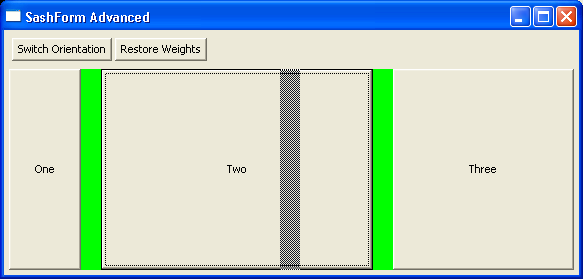Demonstrates SashForm Advanced

//Send questions, comments, bug reports, etc. to the authors:
//Rob Warner (rwarner@interspatial.com)
//Robert Harris (rbrt_harris@yahoo.com)
import org.eclipse.swt.SWT;
import org.eclipse.swt.custom.SashForm;
import org.eclipse.swt.events.*;
import org.eclipse.swt.layout.*;
import org.eclipse.swt.widgets.*;
/**
* This class demonstrates SashForm
*/
public class SashFormAdvanced {
/**
* Runs the application
*/
public void run() {
Display display = new Display();
Shell shell = new Shell(display);
shell.setText("SashForm Advanced");
createContents(shell);
shell.open();
while (!shell.isDisposed()) {
if (!display.readAndDispatch()) {
display.sleep();
}
}
display.dispose();
}
/**
* Creates the main window's contents
*
* @param parent the parent window
*/
private void createContents(Composite parent) {
// Our layout will have a row of buttons, and
// then a SashForm below it.
parent.setLayout(new GridLayout(1, false));
// Create the row of buttons
Composite buttonBar = new Composite(parent, SWT.NONE);
buttonBar.setLayout(new RowLayout());
Button flip = new Button(buttonBar, SWT.PUSH);
flip.setText("Switch Orientation");
Button weights = new Button(buttonBar, SWT.PUSH);
weights.setText("Restore Weights");
// Create the SashForm
Composite sash = new Composite(parent, SWT.NONE);
sash.setLayout(new FillLayout());
sash.setLayoutData(new GridData(GridData.FILL_BOTH));
final SashForm sashForm = new SashForm(sash, SWT.HORIZONTAL);
// Change the width of the sashes
sashForm.SASH_WIDTH = 20;
// Change the color used to paint the sashes
sashForm.setBackground(parent.getDisplay().getSystemColor(SWT.COLOR_GREEN));
// Create the buttons and their event handlers
final Button one = new Button(sashForm, SWT.PUSH);
one.setText("One");
one.addSelectionListener(new SelectionAdapter() {
public void widgetSelected(SelectionEvent event) {
maximizeHelper(one, sashForm);
}
});
final Button two = new Button(sashForm, SWT.PUSH);
two.setText("Two");
two.addSelectionListener(new SelectionAdapter() {
public void widgetSelected(SelectionEvent event) {
maximizeHelper(two, sashForm);
}
});
final Button three = new Button(sashForm, SWT.PUSH);
three.setText("Three");
three.addSelectionListener(new SelectionAdapter() {
public void widgetSelected(SelectionEvent event) {
maximizeHelper(three, sashForm);
}
});
// Set the relative weights for the buttons
sashForm.setWeights(new int[] { 1, 2, 3});
// Add the Switch Orientation functionality
flip.addSelectionListener(new SelectionAdapter() {
public void widgetSelected(SelectionEvent event) {
switch (sashForm.getOrientation()) {
case SWT.HORIZONTAL:
sashForm.setOrientation(SWT.VERTICAL);
break;
case SWT.VERTICAL:
sashForm.setOrientation(SWT.HORIZONTAL);
break;
}
}
});
// Add the Restore Weights functionality
weights.addSelectionListener(new SelectionAdapter() {
public void widgetSelected(SelectionEvent event) {
sashForm.setWeights(new int[] { 1, 2, 3});
}
});
}
/**
* Helper method for our maximize behavior. If the passed control is already
* maximized, restore it. Otherwise, maximize it
*
* @param control the control to maximize or restore
* @param sashForm the parent SashForm
*/
private void maximizeHelper(Control control, SashForm sashForm) {
// See if the control is already maximized
if (control == sashForm.getMaximizedControl()) {
// Already maximized; restore it
sashForm.setMaximizedControl(null);
} else {
// Not yet maximized, so maximize it
sashForm.setMaximizedControl(control);
}
}
/**
* The application entry point
*
* @param args the command line arguments
*/
public static void main(String[] args) {
new SashFormAdvanced().run();
}
}
Related examples in the same category